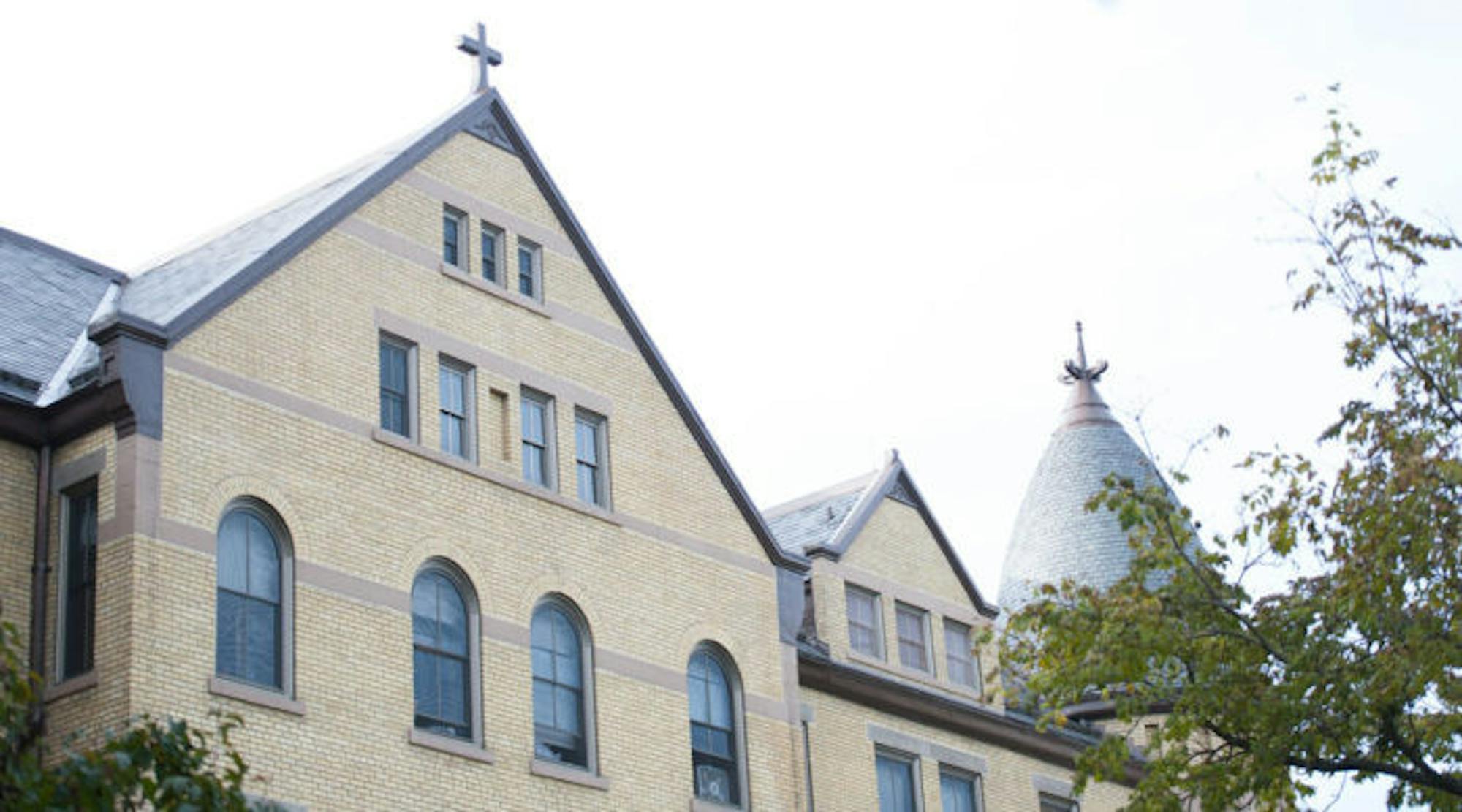It was the Saturday night before Halloween when senior Kevin Hottinger, a Sorin resident assistant on duty, heard the screams.
He raced up to the third floor of the dorm, where he found the cause of the commotion — a bat. After grabbing the designated “bat net” in his rector’s office, he captured the animal and put it in the dorm’s work out room until Sue Beth Laskowski, a Rose Pest Solutions technician, could come.
“When pest control finally did come, it was the lovely Sue Beth, our close friend, and coincidentally, she was coming from a Halloween party,” Hottinger said. “Of course, she was dressed as a bat.”
Between Aug. 14 and Oct. 30, Notre Dame received 11 reports of bats in residence halls, including Badin and Sorin, Kim Kolk, assistant director of space planning and logistics, said in an email.
Sorin residents also keep an unofficial count of bats in their dorm, and totaled 21 bats between Aug. 17 and Oct. 30, sophomore Ben Walter said.
“It’s kind of become a part of the Sorin tradition, I guess,” he said. “At the Keenan Revue last year, they had a guy dress up as Batman and he was like ‘I’m from Sorin’ so we just kind of take it as a Sorin trait, like the one thing people from other dorms know about Sorin since we’re so small, just like ‘Oh they have bats.’”
Howard Hall residents have also found bats in their dorms in past years. When she was a freshman, Howard resident and current junior Hannah Dutler encountered a bat while preparing for a dance.
“I was sitting on the ground doing my makeup and my friend was behind me doing my hair so there was two of us in the room and all of the sudden we saw this thing come at us in the mirror,” she said. “People started screaming. I thought it was a bird and it hit the mirror and went on the ground. He was crawling on the ground and I was like ‘What is that?’ It was bat, so we were both screaming and ran out of the room and locked it in the room.”
Saint Mary’s also has incidences of bats in their residence halls.
Seniors Annie Clare and Sarah Wehby had a bat in their room in Le Mans Hall during the first week of classes. After waking up at 5 a.m., Clare said she felt a presence on her head.
“I touched my head, and [the bat] started like flying in my hair,” Clare said. “So I freaked out … I don’t know what I thought it was, because I just felt its wings. And then I started to take it out and it started screaming.”
Eventually, Clare was able to detach the bat from her hair and it flew into her window between the glass and the screen. Clare and Wehby alerted the front desk attendant, and security was able to capture the bat before releasing it later.
“One of the biggest issues was after they caught the bat, they let it go,” Wehby said. “And everyone was like, you’re supposed to keep it and test it for rabies because if it didn’t have rabies, we didn’t need the shot. But they just let the bat go.”
The administration released the bat from Clare and Wehby’s room rather than testing it because they were not aware it had come into contact with the students, Saint Mary’s vice president of student affairs Karen Johnson said.
“The student that came and said the bat that had been on her, we did not capture that bat because we did not know until the bat had been taken out that it had [been on her],” Johnson said. “But from now on if a student says they have been touched by a bat we will try to capture that bat.”
Saint Mary’s director of security Dave Gariepy said while the incident in Clare and Wehby’s room occurred before Saint Mary’s had bat protocol, in the future the school will capture bats for rabies testing to ensure students’ well-being.
“If it’s a situation in which it would be in a student’s room and the student is sleeping and so we wouldn’t really know if there was close contact, then we would want to capture the bat, send it to the health department for testing to see if it’s rabid — which it’s very rare that they are,” Gariepy said.
Saint Mary’s bat protocol was adopted this fall, Gariepy said. Johnson said it came from existing Notre Dame protocol.
“We’ve never had a student who felt like the bat had been on them, so we just took Notre Dame’s protocol,” Johnson said. “They sent it to me and we did what they do.”
Notre Dame’s bat protocol involves contacting Rose Pest Solutions, a pest management vendor, “to immediately capture the bat for release or testing” when one is found in a building on campus, Kolk said.
“When this happens, Rose Pest also analyzes the residence hall or building and reports any visible potential cause for bats, which is addressed by the University’s Facilities staff or the building manager,” she said.
Kolk said the University also takes several steps to decrease the number of bats in dorms. These efforts include “building bat houses around campus in an effort to keep bats in bat houses and out of halls/academic buildings,” tightening screens and fan filters and running vents in buildings to keep bats out of them, “installing door sweeps, metal cages, and other mechanisms on halls to deter bat entry” and instructing students to keep doors and windows shut to prevent bat entry.
Last April, Walter wrote a Letter to the Editor in The Observer, addressing the bat issue in Sorin. He said he feels the University’s response to the issue has improved drastically since then.
“At the beginning of this year, there was a huge group of people out there for probably four days,” he said. “They had this thermal drone trying to detect holes in the building, they flew around. So they really kicked it into gear at the beginning of this year to try to get [the bats] all kicked out. They went into everybody’s room and sealed their windows and made sure their screens were good so I really felt like they did a lot to combat it this year.”
Johnson also said Saint Mary’s looked to biology professor Laura Kloepper for advice, due to her extensive research of bats. Kloepper’s focus is in echolocation.
“I’m trying to understand how bats are using this special sense they have, which echolocation is a sense that when they use sound, they make a picture of their environment,” Kloepper said. “So they send a really loud sound out into the environment, it comes back as an echo to the bat, and that’s how they can make a picture.”
The majority of the incidents of bats in living spaces is due to the bats being startled or finding difficulty with getting out where they came in. Bats can go into spaces as small as a dime, Kloepper said.
“As long as we’ve had buildings as humans, bats have been finding their way in there,” Kloepper said. “Most of the time it doesn’t cause a problem whatsoever, they tuck up in the attic, and we don’t even know they’re there. But what happens is when they take up residence in the summer, and then students start to come back into the dorm, and they’re moving around and making all these sounds, and that wakes up the bats and the bats get confused.”
Gariepy said Saint Mary’s security has not received a call reporting a bat in a residence hall since Sept. 5.
“The buildings are just old, and they’re large, and bats really can just find easy access to buildings when they’re such big buildings,” Gariepy said. “Usually, it’s the beginning of the season when we would start getting a little bit of cold weather, where we’ll get some of them entering the building.”
The majority of bats reported on campus are not in students’ rooms, Gariepy and Johnson emphasized, but rather in the hallways.
Rabies is “100 percent fatal,” Kloepper said, so if there is a possibility of contact, preventative measures must be taken. However, testing the bat for rabies requires killing the bat, so the ideal course of action is to avoid contact.
“If any individual has had an encounter with a bat, it’s recommended that the bat try to be caught to bring [it] in for testing,” Kloepper said. “Unfortunately, it means that the bat has to be sacrificed or killed for the test because you have to kill the bat to do the test.”
While the risk of contracting rabies is small, Kolk said, if a person touches a bat, or wakes up to one in their room, Notre Dame encourages students to visit University Health Services or a physician.
“Only a very small percentage of bats carry rabies; however, if a person is bitten by a bat with rabies, once the symptoms begin to manifest, it is too late to treat the disease and it is nearly 100 percent fatal,” she said. “As such, we strongly recommend students who may have had potential exposure to seek proactive treatment, but we cannot require them to do so.”
Students need only worry if they came in contact with a bat, Kloepper said. Otherwise, they do not pose any risk.
“As long as you’re not touching it, and you’re not interacting with that bat in any way, having it just flying around the dorm, it’s no reason to be concerned,” Kloepper said. “It’s natural that we kind of panic if we see something flying in our house. The best thing to do is be as calm as possible, separate yourself from the bat and then call security.”
Notre Dame, Saint Mary’s communities discuss multiple incidences of bats in residence halls
Observer File Photo
Sorin Hall, pictured, is one of many residence halls at Notre Dame and Saint Mary’s that have encountered run-ins with bats inhabiting dorm rooms and other living areas.









